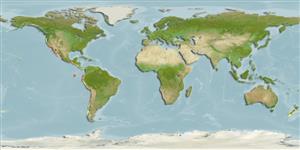>
Ophidiiformes (Cusk eels) >
Ophidiidae (Cusk-eels) > Ophidiinae
Etymology: Ophidion: Diminutive of Greek, ophis = serpent (Ref. 45335).
Eponymy: Ellen Browning Scripps (1836–1932) was an Englishborn philanthropist, newspaper owner and columnist who emigrated to the USA with her father (1844). Among her many foundations is the Scripps Institute of Oceanography, California (1903). (Ref. 128868), visit book page.
More on author: Hubbs.
Environment: milieu / climate zone / depth range / distribution range
Ecología
marino demersal; rango de profundidad 0 - 110 m (Ref. 34024), usually 3 - 7 m (Ref. 2850). Subtropical
Eastern Pacific: Point Arguello in California, USA (Ref. 2850) to Baja California. The single record from the Gulf of California is erroneous.
Tamaño / Peso / Age
Maturity: Lm ? range ? - ? cm
Max length : 28.0 cm TL macho / no sexado; (Ref. 2850)
Short description
Claves de identificación | Morfología | Morfometría
Espinas dorsales (total) : 0; Radios blandos dorsales (total) : 124 - 153; Espinas anales: 0; Radios blandos anales: 99 - 126; Vértebra: 65 - 69. Branchiostegal rays: 7 (Ref. 36413). Pelvic fin consists of one ray with two branches of unequal length (Ref. 36413).
Uncommon species ranging from the shore to 110 m depth (Ref. 34024). Usually found on sand bottom from 2.7-7 m depth (Ref. 2850). Oviparous, with pelagic larvae (Ref. 36413). Oval, pelagic eggs float in a gelatinous mass (Ref. 205).
Life cycle and mating behavior
Madurez | Reproducción | Puesta | Huevos | Fecundidad | Larva
Nielsen, J.G., D.M. Cohen, D.F. Markle and C.R. Robins, 1999. Ophidiiform fishes of the world (Order Ophidiiformes). An annotated and illustrated catalogue of pearlfishes, cusk-eels, brotulas and other ophidiiform fishes known to date. FAO Fish. Synop. 125(18):178p. Rome: FAO. (Ref. 34024)
IUCN Red List Status (Ref. 130435: Version 2024-1)
Threat to humans
Harmless
Human uses
Pesquerías: sin interés
Herramientas
Special reports
Download XML
Fuentes de Internet
Estimates based on models
Preferred temperature (Ref.
123201): 13.1 - 29.1, mean 22.5 °C (based on 227 cells).
Phylogenetic diversity index (Ref.
82804): PD
50 = 0.5000 [Uniqueness, from 0.5 = low to 2.0 = high].
Bayesian length-weight: a=0.00204 (0.00116 - 0.00361), b=3.18 (3.02 - 3.34), in cm total length, based on LWR estimates for this species & (Sub)family-body (Ref.
93245).
Nivel trófico (Ref.
69278): 3.5 ±0.50 se; based on food items.
Resiliencia (Ref.
120179): Alto, población duplicada en un tiempo mínimo inferior a 15 meses (Preliminary K or Fecundity.).
Fishing Vulnerability (Ref.
59153): Low vulnerability (18 of 100).
